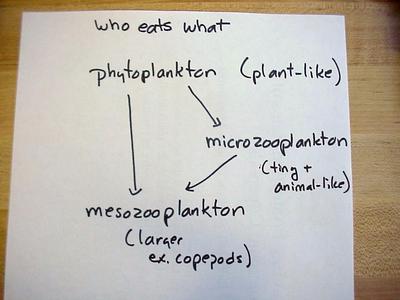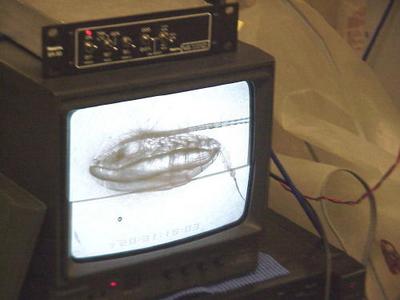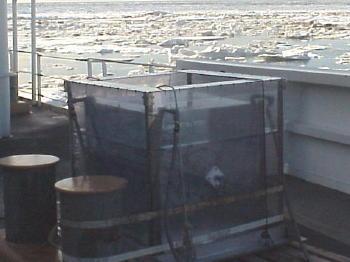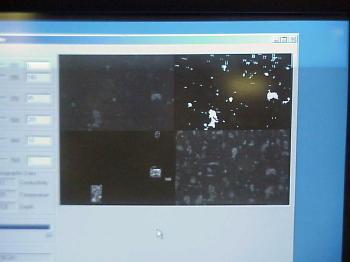28 July, 2002
When we’re at the deep stations, days and nights
really run together. We started our Haps core work
around 2:00 this morning, but others put the core in,
and I didn’t have to be on deck until 4 when the first
one came out. By the time we finished it was 7:45 and
time for breakfast. Every time we put down the Haps
core at this depth and then have to wait for it to
come back up, I remind myself that it is going down
nearly two miles to the bottom of the ocean before it
starts back up!
During the day today we moved to our next deep
station. We’re again at 3000 meters and, because we
arrived a bit later in the day, I can plan to have a
bit of time off before I go to work again tomorrow.
If you check the ship’s cruise path at the JOSS
website at http://www.joss.ucar.edu/sbi/catalog,
you’ll see that we are in East Barrow Canyon, an area
of the Beaufort Sea north and east of Point Barrow,
Alaska. Point Barrow is the northernmost point in the
United States at a latitude of 71 degrees north. By
early August, the sun will actually set in Barrow and,
by the end of our cruise, we’ll see some actual
darkness during the night time hours.
There are several people on board studying plankton
(organisms that drift in the water), both zooplankton
(animals) and phytoplankton (plants). Carin Ashjian,
an associate scientist at the Woods Hole Oceanographic
Institute (WHOI) and Stephane Plourde, a post doc from
WHOI, are both working with zooplankton. One of the
two studies they are doing on board is a study of the
grazing (eating) and egg production rates of dominant
copepods. A copepod is a large type of zooplankton
(see the picture below) somewhat like a shrimp. They
hope to better understand the ecosystems (how living
things fit with each other and with the environment
they live in) of the Arctic Ocean shelf and basin, how
carbon is processed by the plankton (see the journal
from July 26) and how this all affects the transfer of
material between the shelf and the basin. Their work
is closely tied to other studies done on board. Carin
and Stephane study the mesozooplankton, the larger
ones, which eat both microzooplankton (micro = small)
and the phytoplankton. The microzooplankton also eat
the phytoplankton (see the diagram in the photo
below). Others are studying the phytoplankton and the
microzooplankton. It all fits together!
Carin and Stephane start with the water from the CTD
cast which contains phytoplankton and
microzooplankton. They then use nets that are dropped
down and brought up vertically to capture the
zooplankton. They take the CTD water, add a known
number of copepods (mesozooplankton) to it and
incubate it (put it in a natural environment where
they can feed) for 24 hours (see photo below). They
remove the copepods, count them, and use that
information in conjunction with information about
phytoplankton and microzooplankton to get an idea of
the grazing rate (how much they are eating). If there
are lots of phytoplankton around and the copepods
can’t eat it all, the phytoplankton will die and sink
to the bottom. That adds to the benthos (bottom
organisms) that Jackie Grebmeier and others are
sampling. (I told you it all fits together!) Carin
and Stephane also look for eggs on the copepods as a
measure of the potential growth of the population.
Early results show that egg production seems to be
less in the basin (deep water) than on the shelf,
possibly because food is less available in the deeper
water.
The other work that Carin and Stephane are doing uses
an amazing underwater microscope called a video
plankton recorder (VPR), an instrument that actually
photographs plankton and parcticles with a light that
flashes 60 times each second. With this, they can get
a picture (it comes up on a screen in the lab) of the
organisms at each depth. By combining this data with
information about water currents, they can get an idea
of how plankton and parcticles move between the shelf
and the basin. When combined with data from other
researchers, this information will provide a model of
how the ecosystem works in these regions. The final
goal is to use this model to predict the impact of
climate change in this region.

This is a simple diagram of who eats what (a food web) among the plankton. The arrow points to the organism that does the eating. For example, mezoplankton eat both microzooplankton and phytoplankton.

Carin is one of several scientists on board who are studying plankton. In this picture Carin is using a microscope with a camera on top to project images of the copepods onto a screen.

Stephane Plourde works with Carin on the study of grazing and egg production rates of copepods.

Copepods are a part of the larger sized zooplankton called mesozooplankton. They are related to shrimp but must be viewed with a microscope. With a camera attached to her microscope, this is what Carin sees on her screen.

Carin and Stephane put their copepods into water from the CTD cast that contains phytoplankton and microzooplankton. That water is then incubated on deck in the uncubator you see here for 24 hours. After they analyze the results, they can tell how much the copepods are eating and how fast they are eating it.

Stephane and Carin are putting the VPR (video plankton recorder) into the water.

THis is the image sent back by the video plankton recorder. It is so clear that, in the lower right quarter of the picture, you can identify diatoms and copepods as they swim by.
Contact the TEA in the field at
.
If you cannot connect through your browser, copy the
TEA's e-mail address in the "To:" line of
your favorite e-mail package.
|
